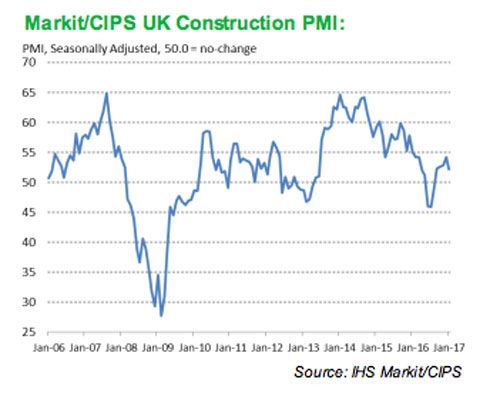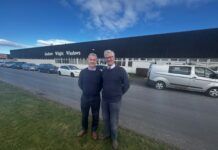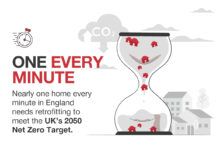
 January data revealed a slowdown in construction sector growth, with business activity and incoming new work both expanding at weaker rates than at the end of 2016.
January data revealed a slowdown in construction sector growth, with business activity and incoming new work both expanding at weaker rates than at the end of 2016.
Despite this, survey respondents signalled that confidence regarding the year-ahead outlook picked up to its strongest since December 2015, largely reflecting new project starts and a resilient economic backdrop. This contributed to the fastest rise in employment numbers since May 2016. Meanwhile, exchange rate depreciation against the euro and the US dollar resulted in the strongest rate of input cost inflation since August 2008.
The seasonally adjusted Markit/CIPS UK Construction Purchasing Managers’ Index (PMI) registered 52.2 in January, down from 54.2 in December. As a result, the headline index signalled the weakest rise in overall business activity since the post-referendum recovery began in September 2016. All three sub-sectors (housing, commercial and civil engineering) recorded softer rates of output growth in January.
Although housebuilding remained the best performing category, the latest expansion was the weakest for five months. Slower growth of business activity largely reflected a moderation in new order gains at the start of 2017. The latest rise in new work was the least marked since October 2016. While some construction firms commented on a boost to sales from improving domestic economic conditions, there were also reports citing subdued willingness to spend among clients in January. There were more positive trends in terms of staff hiring across the construction sector at the start of 2017, which survey respondents mainly attributed to planned project starts during the coming months. The latest increase in employment numbers was the fastest for eight months, while sub-contractor usage rose at the steepest pace since December 2015. Stronger job creation also reflected a sustained improvement in business confidence among construction companies in January.
More than half of the survey panel (51%) forecast a rise in business activity over the next 12 months, while only 7% anticipate a reduction. The index measuring construction firms’ year-ahead expectations has now picked up in five of the past six months. Meanwhile, latest data indicated a modest rebound in input buying in response to increased workloads and forthcoming project starts. This resulted in greater pressure on supplier capacity, with lead times from vendors lengthening to the largest degree since June 2015. Average cost burdens increased at the steepest pace for almost eight-and-a-half years in January. This was widely linked to rising prices for imported materials at the start of 2017.
Tim Moore, senior economist at IHS Markit and author of the Markit/CIPS Construction PMI, said: “UK construction firms experienced a subdued start to 2017, with all the key categories of activity losing momentum. While housebuilding retained its position as the fastest growing part of the construction sector, the latest upturn was the weakest since the postreferendum rebound emerged in September 2016.
“New business volumes also expanded at a softer pace in January, but there were more positive trends in terms of staff hiring and business optimism regarding the year-ahead outlook. The latest survey revealed an accelerated rise in payroll numbers at construction companies, as well as the fastest upturn in sub-contractor usage since the end of 2015. A number of survey respondents commented on a boost to their workloads from the resilient economic backdrop, alongside a strong pipeline of new project starts in 2017.
“Meanwhile, the weak pound continued to have an inflationary impact on the UK construction sector in January. Purchasing costs increased at the strongest rate for almost eight-and-a-half years, as suppliers sought to pass on higher prices for commodities and imported construction materials.”
David Noble, group chief executive officer at the Chartered Institute of Procurement & Supply, said: “Despite the biggest rise in input costs since August 2008, the sector was in buoyant mood at the start of the year, with highest level of confidence since December 2015.
“Continuing cost pressures from the weak pound and escalating commodity prices failed to impact significantly on purchasing volumes, as input buying increased following last month’s slight fall while job creation rose to an eight-month high. Previously stalled projects and plans were given the go-ahead as the sector ensured sufficient staff resource was in place to meet future demand.
“However, the dark cloud on the horizon was the continuing pressures on supply chains. Material shortages, lengthening delivery times and supplier performance, the weakest since June 2015, could become a roadblock to the sector’s continuing growth. “In the short term at least, the outlook is positive, as long as economic conditions remain supportive and firms are able to control their rising costs.”



